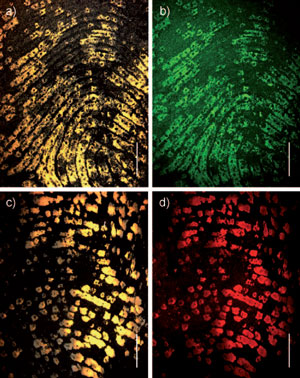| Posted: December 15, 2008 |
Fingerprints from crime scenes will soon reveal drug abuse |
|
(Nanowerk News) In order to arrest a culprit, police look for fingerprints at the scene of the crime. Magnetic powder is applied to the surfaces of objects with a magnetic brush to make these latent fingerprints visible. It may now be possible to use latent fingerprints to detect the use of drugs as well.
|
|
As reported in the journal Angewandte Chemie, forensic scientists would not even have to change the magnetic brush technique they have used since the 1960s: British scientists at the University of East Anglia in Norwich and King’s College in London have developed a process based on magnetic particles and antibodies that causes fingerprints to fluoresce if they were made by a drug user ("Imaging of Latent Fingerprints through the Detection of Drugs and Metabolites").
|
 |
| Detection of methadone and EDDP in a fingerprint. a) Brightfield and b) fluorescence images of a section of a fingerprint, obtained after incubation of antimethadone-antibody-functionalized magnetic particles and Alexa Fluor 488 dye-tagged secondary antibody. c) Brightfield, and d) fluorescence images of a section of a fingerprint, obtained after incubation of antiEDDP-antibody-functionalized magnetic particles and Alexa Fluor 546 dye-tagged secondary antibody. The scale bars are 2 mm. (Copyright: Wiley)
|
|
Components of drug metabolites can be detected in sweat. “This also works for the tiny amounts of sweat left behind in the characteristic pattern of grooves and ridges of fingerprints left on the objects that were touched,” explains David A. Russell. To do this, Russell and his team used specially coated magnetic particles with antibodies attached. The antibodies bind specifically to drug components or metabolites. Fingerprints of volunteer test subjects from drug clinics were dusted with this magnetic powder. The prints were then treated with a solution containing an antibody bound to a fluorescing dye. This second antibody binds to the first. If the fingerprint was made by a drug user, it turned yellowish brown. Under visible light, these fingerprints glowed green or red, depending on the fluorescent dye used.
|
|
By using the corresponding specific antibodies, the scientists were able to detect THC (the main active component of marijuana), benzoylecgonine (the primary metabolite of cocaine), and methadone and the primary metabolite of methadone in the fingerprints of test subjects. Variation of the antibodies makes it possible to develop detection procedures for other substances of interest.
|
|
The characteristic pattern of the fingerprint is maintained. The fingerprints are highly resolved and can be lifted for comparison with known fingerprints, just as in the standard procedure. At higher magnification it is even possible to see the tiny sweat pores along the ridges of the fingertip, which can also be used for unambiguous identification.
|
|
“The advantage of this method is that potentially only simple, portable equipment is needed, which can be brought along for a crime scene investigation with no problem,” says Russell. “The magnetic particles make it possible to remove excess reagent with the usual magnetic brush, no complex washing procedures would be needed.”
|

